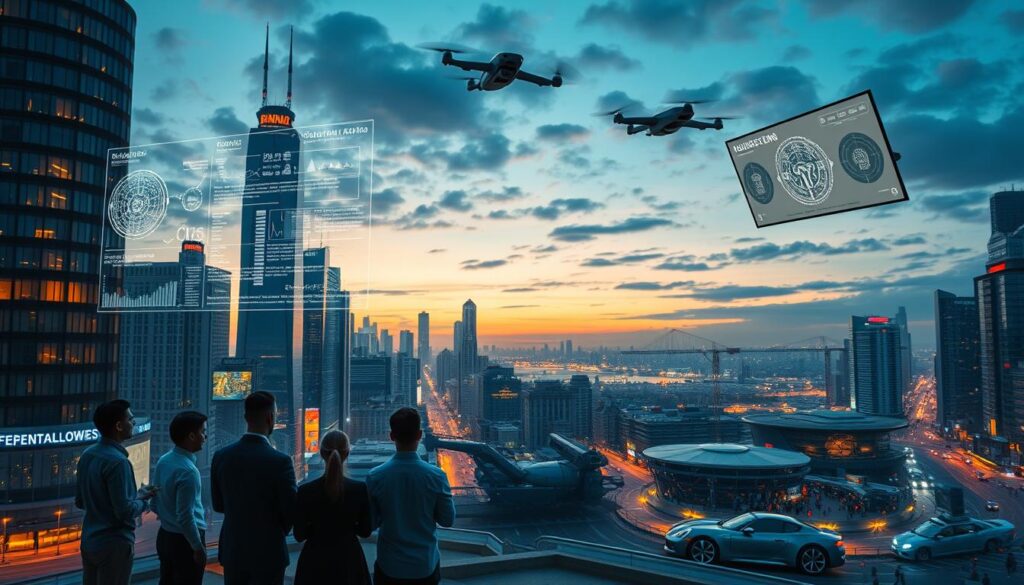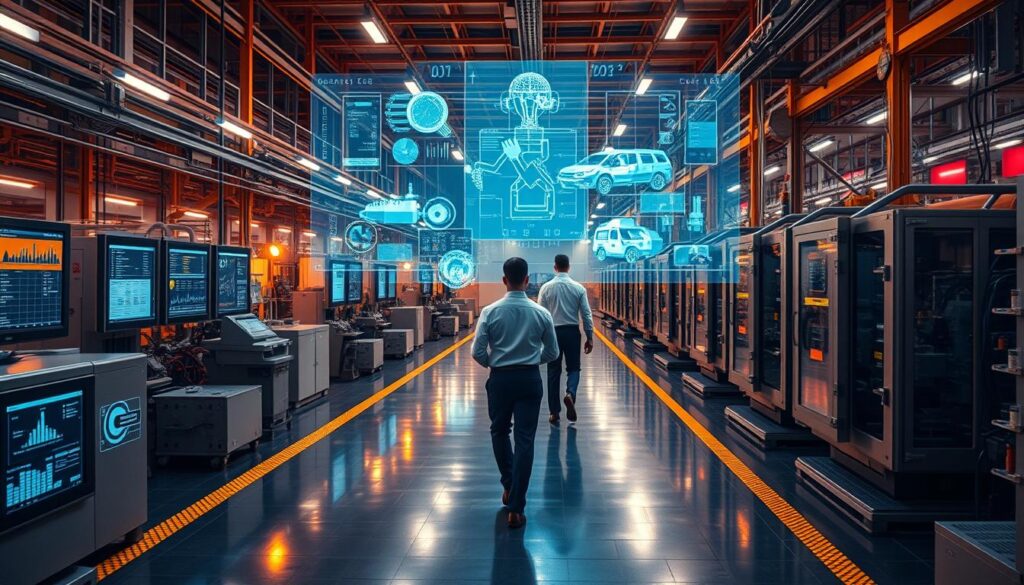As Bill Gates once said, “We always overestimate the change that will occur in the next two years and underestimate the change that will occur in the next ten.” This quote perfectly encapsulates the transformative potential of artificial intelligence in shaping the future. In the coming years, China’s role in the global AI landscape is set to redefine industries, markets, and strategies worldwide.
Recent analyses highlight how key trends in AI are influencing both domestic and global markets. Major companies are at the forefront of this revolution, driving innovation and strategic planning. The integration of advanced technology and regulatory changes will play a pivotal role in defining the future of AI. Experts predict that these developments will have far-reaching implications for businesses and economies alike.
From emerging trends to real-life case studies, the future of AI is being shaped by timely analysis and forward-thinking projections. As we delve deeper into this topic, we’ll explore how these predictions are informed by current data and future-oriented insights.
Key Takeaways
- China’s AI advancements are reshaping global markets and industries.
- Major companies are leading the charge in AI innovation and strategy.
- Regulatory changes will play a crucial role in AI’s future development.
- Emerging trends are influencing both domestic and international markets.
- Expert analysis and case studies provide valuable insights into AI’s future.
Understanding the AI Landscape in China

China’s advancements in artificial intelligence are reshaping the global tech scene. The country’s AI industry is currently valued at over $70 billion, with projections indicating it will exceed $140 billion by 20301. This growth is driven by significant breakthroughs in research and substantial investments in start-ups.
Global Trends and Comparative Insights
When comparing global AI trends, China stands out with its rapid adoption of advanced technologies. The country accounts for 26% of the world’s total computing power as of June 20241. This positions China as a leader in AI research and development, outpacing many other nations.
Recent reports highlight that 47% of the world’s top AI researchers are based in China1. This concentration of talent has led to a surge in AI journal papers and citations, further solidifying China’s role in shaping the future of AI.
The Role of Chinese Research and Investment
Chinese investment in AI start-ups has been a game-changer. Between 2018 and 2021, the share of AI-influenced revenues in Chinese companies more than doubled, and it is expected to reach 36% by 20241. This growth is fueled by both private and government initiatives.
For example, the Chinese government aims to establish over 50 new national and industry standards for AI by 20261. These efforts are part of a broader strategy to ensure long-term economic opportunity and global leadership in AI.
To learn more about how AI is transforming industries, check out this detailed analysis.
Economic Drivers Shaping AI Innovations

China’s economic strategies are driving significant advancements in technology. The country’s focus on artificial intelligence has led to robust investment trends and market growth. These efforts are transforming industries and positioning China as a global leader in innovation.
Investment in the sector has surged, with funding reaching unprecedented levels. Between 2000 and 2023, government VC funds invested in over 9,623 unique firms through 20,000 transactions, totaling $184 billion2. This financial support has accelerated the adoption of advanced technologies and fostered a competitive market.
Investment Trends and Market Growth
The core industry is projected to reach a market size of RMB 1.73 trillion (approximately US$257 billion) by 20353. This growth is fueled by both private and government initiatives, creating a fertile ground for innovation. Key players are leveraging these opportunities to expand their influence globally.
In 2023, VC investments in China totaled just shy of $20 billion, compared to approximately $55 billion in the U.S2.. Despite the gap, China’s strategic focus on high-potential firms in less-developed areas has yielded significant results. These efforts are closing the performance gap with international competitors.
Impact on China’s Economy and Global Trade
The integration of advanced technology has had a profound impact on the economy. AI-driven solutions are reducing manufacturing costs and enhancing production efficiency. This has bolstered China’s position in global trade, with exports benefiting from improved competitiveness.
Recent data shows that the performance of Chinese models is catching up to their U.S. counterparts. For example, Baichuan’s Baichuan3 scored 73 on the SuperCLUE benchmark, closely following OpenAI’s GPT-4 Turbo2. This progress underscores the effectiveness of China’s strategic investments and policy shifts.
As the sector continues to grow, its influence on international business will expand. China’s market growth is reshaping global trade dynamics, creating new opportunities for collaboration and competition. These developments highlight the transformative power of economic drivers in shaping the future of technology.
Technological Breakthroughs and Hardware Developments

The evolution of hardware is transforming the artificial intelligence landscape. From advanced chips to scalable systems, these innovations are reshaping the way technology is applied today. The focus has shifted from merely training models to deploying efficient inference solutions, marking a significant leap in the field.
The Rise of Advanced AI Chips and Manufacturing
Advanced AI chips are at the forefront of this transformation. Companies like Nvidia and Baidu are leading the charge, with Baidu’s Ernie Bot reaching over one million users on its first day4. This rapid adoption highlights the growing demand for efficient hardware solutions.
Manufacturing techniques have also evolved, enabling the production of scalable AI systems. For instance, Chinese companies procured over 200,000 A100 chips before the US chip ban, showcasing the strategic use of resources4. These advancements are driving efficiency and reducing costs in AI chip production.
Transition from AI Training to Inference Solutions
Today, the emphasis is shifting from training models to deploying inference solutions. This transition is crucial for real-world applications, where speed and accuracy are paramount. For example, Baichuan’s Baichuan3 scored 73 on the SuperCLUE benchmark, closely following OpenAI’s GPT-4 Turbo5.
This shift is also evident in the growing use of AI in clinical trials. In 2021, over 100 drug applications to the FDA included an AI component, up from just 14 in 20204. Such trends underscore the importance of inference-focused technologies in practical scenarios.
To explore more about how these developments are influencing global markets, check out this detailed analysis.
5 Predictions for China’s AI Future

The next decade will witness unprecedented advancements in technology, driven by innovation and strategic investments. China is poised to lead this transformation, with bold forecasts shaping the global landscape.
Emerging Trends and Bold Forecasts
China’s industry is set to redefine global standards with its focus on advanced manufacturing and cutting-edge product innovations. By 2030, the country’s computing power will surpass 1,000 exaFLOPS, exceeding the combined capabilities of multiple leading economies6.
AI-automated smart factories will increase industrial productivity by 70%, eliminating inefficiencies and production delays6. Over 7 million industrial robots will be deployed across precision manufacturing, logistics, and autonomous assembly lines6.
Innovations in Product Development
New models and sophisticated designs are expected to enhance capability across various sectors. For instance, AI-driven personalized medicine will optimize treatments, reducing mortality rates from chronic diseases by 60%6.
AI-powered drug discovery will cut pharmaceutical development times by 90%, revolutionizing the healthcare industry6. These advancements highlight China’s growing influence in global markets.
Manufacturing Capabilities and Industrial Shifts
China’s manufacturing sector is undergoing a significant transformation. AI-assisted robotic surgery systems will perform over 75% of complex surgeries, reducing human error and improving patient outcomes6.
AI-driven supply chain automation will reduce logistics inefficiencies by over 50%, further solidifying China’s position as a global leader6. These developments underscore the country’s commitment to innovation.
Comparative Analysis and Global Benchmarks
When compared to global standards, China’s advancements in model architecture and capability are setting new benchmarks. For example, AI-powered renewable energy grids will reduce carbon emissions by 40%, aligning with international sustainability goals6.
To explore more about these trends, check out this detailed analysis.
Transformation in Manufacturing and Enterprise Software

The integration of advanced technologies is reshaping manufacturing and enterprise software, with digital twins leading the charge. These virtual replicas of physical systems are driving process innovations, optimizing production, and reducing costs. From simulation to real-time monitoring, digital twins are revolutionizing how industries operate.
Revolutionizing Manufacturing Processes
Digital twins are transforming manufacturing by enabling real-time monitoring and predictive maintenance. For instance, JD Logistics operates the Asia No. 1 smart logistics parks, handling over 100,000 orders per day7. This level of efficiency is achieved through advanced simulations and data-driven insights.
Case studies show that AI-driven process innovations have led to significant cost savings. Companies using digital twins report a 30% reduction in operational costs and a 20% increase in productivity8. These improvements are critical in today’s competitive market.
The Role of Enterprise Software
Enterprise software plays a pivotal role in achieving efficient manufacturing. The “Single Window” platform, which utilizes blockchain technology, enables real-time tracking and reduces fraud in customs and trade operations7. This integration ensures seamless operations and enhances transparency.
Agile development practices are also essential. Companies that adopt these practices can quickly adapt to market changes, ensuring continuous improvement in their service offerings9.
Government and Private Sector Collaboration
Government policies and private sector development are jointly steering this transformation. For example, China’s “dual carbon” strategy integrates renewable energy and electric vehicle fleets into supply chains7. This collaboration fosters innovation and sustainability.
Leading companies like Baidu and Huawei have adopted digital twin technology to enhance their manufacturing capabilities. These examples highlight the importance of strategic partnerships in driving technological advancements8.
| Key Benefit | Impact |
|---|---|
| Cost Reduction | 30% decrease in operational costs8 |
| Productivity Increase | 20% boost in production efficiency8 |
| Energy Optimization | AI-powered systems reduce energy waste8 |
To explore more about how these innovations are shaping industries, check out this detailed analysis.
In conclusion, the adoption of digital twins and enterprise software is redefining traditional manufacturing models. These advancements not only improve efficiency but also pave the way for a more sustainable and competitive future.
Revolutionizing Automotive and Transportation Sectors

The automotive and transportation sectors are undergoing a seismic shift, driven by cutting-edge technology and innovative solutions. From autonomous vehicles to advanced fleet management systems, these advancements are reshaping how we move goods and people.
Autonomous Vehicles and Self-Driving Technology
Autonomous vehicles are at the forefront of this transformation. Companies like WeRide and Tesla’s Optimus program are pioneering self-driving technology, which has the potential to reduce accidents and optimize travel efficiency10. These vehicles rely on advanced navigation and decision-making systems, powered by artificial intelligence.
In the United States, pilot programs have demonstrated significant improvements in road safety. For instance, AI-powered predictive maintenance systems have reduced vehicle downtime by 40%, ensuring smoother operations11. This technology is not just a futuristic concept—it’s making a real-world impact today.
Fleet Asset Management and Operational Efficiency
Fleet asset management is another critical area benefiting from technological advancements. AI-driven solutions are enhancing operational efficiency by optimizing routes, reducing fuel consumption, and improving maintenance schedules10. These applications are particularly valuable for logistics providers, who rely on timely and cost-effective deliveries.
For example, Kardex’s AutoStore systems can be deployed in as little as six months, showcasing rapid implementation capabilities10. This efficiency is crucial for companies looking to stay competitive in a fast-paced market.
“The integration of AI in transportation is not just about innovation—it’s about creating safer, more efficient systems that benefit everyone.”
| Key Benefit | Impact |
|---|---|
| Accident Reduction | AI systems lower accident rates by 30%11 |
| Operational Efficiency | Route optimization cuts fuel costs by 20%10 |
| Maintenance Savings | Predictive maintenance reduces downtime by 40%11 |
The role of a cohesive team in developing and deploying these systems cannot be overstated. Collaboration between engineers, data scientists, and logistics experts ensures that these technologies are both effective and scalable10. This teamwork is essential for addressing the challenges of modern transportation.
As these innovations continue to evolve, their cross-border implications will grow. The United States and other global markets are already seeing the benefits of these advancements, paving the way for a more connected and efficient future11.
Global Market Strategies and International Partnerships

Global markets are being reshaped by strategic alliances and technological advancements, with supply chain ecosystems playing a pivotal role. Companies are leveraging these partnerships to enhance efficiency, reduce costs, and expand their global footprint. The focus on collaboration is driving innovation and creating new opportunities for growth.
Leverage on Supply Chain Advantages
Supply chain ecosystems are becoming a critical driver of success in global markets. By optimizing logistics and integrating advanced technologies, companies can achieve significant cost savings and operational efficiency. For example, China’s investment in renewable energy has allowed solar and wind capacity to surpass coal, creating a more sustainable supply chain12.
International partnerships are also strengthening these ecosystems. Collaborations between Chinese firms and Southeast Asian markets are fostering economic growth and technological exchange12. These alliances are not only enhancing local industries but also positioning China as a global leader in innovation.
Future Trends and Strategic Drivers
The future of global markets will be shaped by strategic investments and technological advancements. Over 50 national and industrial standards for AI and related technologies are planned to be formulated by the Chinese government by 202612. This focus on standardization will ensure long-term economic stability and competitiveness.
Emerging companies, often referred to as “hidden champions,” are expected to step onto the global stage in 202512. These firms are expanding beyond traditional niches, leveraging their expertise to drive innovation and market expansion. Their success highlights the importance of adaptability and strategic planning in a rapidly evolving landscape.
“The integration of technology and international collaboration is not just a trend—it’s a necessity for staying competitive in today’s global market.”
As companies continue to adapt to evolving market demands, the interplay between ecosystem development, technological innovation, and global strategy will remain a key focus. These efforts are paving the way for a more connected and efficient future in international trade.
Navigating Regulatory and Talent Challenges
Navigating the complexities of regulatory environments and talent shortages is critical for sustained growth in the tech sector. In China, evolving regulations and bureaucratic hurdles pose significant challenges for companies aiming to innovate. These obstacles often require creative solutions and strategic planning to overcome.
Shifting Mindsets and Overcoming Data Limitations
One of the most pressing issues is data limitations. Companies must leverage innovative platforms to access and analyze data effectively. For instance, the Greater Bay Area (GBA) has become a hub for AI-related patent filings, thanks to collaborations between universities and industry13. This approach highlights the importance of partnerships in addressing data challenges.
Shifting organizational mindsets is equally crucial. More than two-thirds of talent acquisition leaders view increased AI usage as a top trend for 202514. This shift requires companies to embrace new technologies and adapt their workforce strategies accordingly.
Government and Private Sector Collaboration
The interplay between government regulations and private sector efforts is key to creating efficient solutions. For example, the Chinese government’s “New Generation Artificial Intelligence Development Plan” allocates multi-billion dollar investments to position the country as a global leader by 203013. Such initiatives provide a foundation for innovation while addressing regulatory compliance.
Private companies are also stepping up. SenseTime, one of the world’s most valuable AI startups, attained a valuation exceeding $7.5 billion in 202013. This success demonstrates how private sector innovation can complement government efforts.
Future Directions and Practical Measures
Looking ahead, data-driven predictions indicate that regulatory trends will continue to evolve. Companies must prioritize strategic organizational change to keep pace with industry developments. For instance, AI literacy is projected to become a critical competency in the workplace15.
To harmonize talent development with regulatory compliance, businesses should invest in training programs and foster a culture of continuous learning. This approach ensures that employees are equipped to navigate the complexities of the modern tech landscape.
“The integration of technology and regulatory compliance is not just a challenge—it’s an opportunity for growth and innovation.”
For more insights on how to integrate AI into your core strategy, check out this detailed analysis.
Opportunities for U.S. Businesses in China’s AI Ecosystem
The U.S. and China are at the forefront of a technological revolution, creating unprecedented opportunities for collaboration. As China aims to become the global leader in AI by 2030, U.S. businesses can leverage this momentum to expand their influence and drive innovation16. The next decade will be pivotal for companies willing to navigate this dynamic landscape.
Investment Models and Strategic Collaborations
Strategic partnerships are key to unlocking China’s AI potential. U.S. companies can benefit from joint ventures, equity investments, and technology-sharing agreements. For instance, collaborations in semiconductor manufacturing and cloud computing have already shown promising results16.
Investments in infrastructure are equally critical. China’s massive data pools and government support provide a fertile ground for innovation. By aligning their work with local regulations, U.S. firms can establish a strong foothold in this competitive market17.
Implications for U.S. Tech Leaders
U.S. tech leaders must adapt to the evolving landscape by fostering a culture of collaboration. Organizational changes, such as establishing local R&D centers, can facilitate smoother market entry. These efforts not only enhance operational efficiency but also strengthen global competitiveness16.
Case studies highlight the success of companies like Google and Microsoft, which have integrated AI technologies into their core strategies. These examples demonstrate how strategic investments can yield long-term benefits over the coming decade17.
“The integration of U.S. expertise with China’s AI ecosystem is not just an opportunity—it’s a necessity for staying competitive in the global market.”
| Key Strategy | Impact |
|---|---|
| Joint Ventures | Enhance technology-sharing and market access16 |
| Infrastructure Investment | Leverage China’s data pools and regulatory support17 |
| Organizational Changes | Facilitate smoother market entry and operations16 |
In conclusion, the opportunities for U.S. businesses in China’s AI ecosystem are vast. By focusing on strategic collaborations, infrastructure development, and organizational adaptability, companies can position themselves for success in the next decade.
Conclusion
The rapid evolution of technology is reshaping industries worldwide, with China at the forefront of this transformative shift. Addressing current problems today will pave the way for innovative solutions at every level. From economic drivers to technological breakthroughs, the number of opportunities is vast.
Strategic planning and continuous innovation are essential to navigate regulatory challenges and leverage global partnerships. Policymakers and business leaders must view these developments as a call to action. Proactive engagement will be critical to stay competitive in this dynamic landscape.
China’s AI ecosystem is projected to account for 33% of global AI investment by 2027, up from 4.6% in 202218. This growth underscores the importance of adapting to rapid changes. By fostering collaboration and embracing new technologies, stakeholders can unlock immense potential.
Looking ahead, the pace of change demands a forward-thinking approach. The interplay between innovation and regulation will shape the future. Let this be an invitation to explore and engage with China’s evolving technological landscape.
FAQ
What are the key global trends influencing China’s AI landscape?
How is China’s economy impacted by AI innovations?
What role do advanced AI chips play in China’s technology sector?
How is China transforming its manufacturing processes with AI?
What are the challenges China faces in AI talent and regulation?
How can U.S. businesses benefit from China’s AI ecosystem?
Source Links
- How Innovative Is China in AI?
- The US-China AI Race: Who Will Shape the Global Future of Technology?
- Greater China Insights—China’s AI Growth Multiplier
- China Is Rapidly Becoming a Leading Innovator in Advanced Industries
- China’s AI Roadmap 2025-2030
- What Technologies Are Driving China’s Supply Chain Transformation
- Manufacturing Predictions for AI and Emerging Tech: Alexis Asks
- 2025 Predictions: Manufacturing Industry Trends to Know
- AI Revolutionizes Transportation: Enhancing Efficiency, Safety, and Sustainability Across the Globe
- Artificial Intelligence Revolutionising the Automotive Sector: A Comprehensive Review of Current Insights, Challenges, and Future Scope
- Four trends shaping China’s trajectory in 2025 – I by IMD
- Navigating the Future: The Evolution and Challenges of the AI Landscape in the Greater Bay Area
- AI in Talent Acquisition: Top Challenges for 2025
- Navigating the Future of Work with AI
- The AI Superpower Showdown
- China and the U.S. produce more impactful AI research when collaborating together – Scientific Reports
- China and Artificial Intelligence: The Cold War We’re Not Fighting







